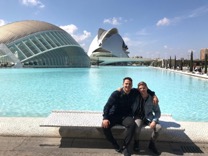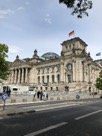
Nathan Gray ’20 — When I walked into my host mother’s apartment in Seville, I was surprised by how very modern it was. Seville is a traditional city in the south of Spain, full of centuries old buildings and only one, very controversial skyscraper. My confusion turned to excitement when I learned that she had chosen the modern apartment because she is an architect. As an architect, she would help me explore a topic that I had been curious about for months: how cultural discussions about art and democracy become recorded in public architecture.
I’ve been chewing on this question since I visited the many courts of London during an immersion trip for Professors Himsel and Morillo’s History of the Common Law course. During a tour of the recently constructed building for the UK’s Supreme Court, the guide pointed out that every detail of the building’s construction was built to reinforce the idea of total equality before the law. For example, in the Supreme Court, the judges sat at the same level as the petitioner in contrast to the lofty placement of the bench in the older Royal Court of Justice. I began to wonder about how public and government architectural spaces make symbolic statements about how a nation views democracy, the state, and their past and how those views are perceived through design.
In addition to my host mother’s architectural expertise, my class on the History of Seville through Art provided me all the intellectual tools and practice for understanding how a political and cultural community shapes and redefines its narrative through its public spaces and how that changes over time. Thanks to the generous support of the Givens Scholarship, I now had the resources to explore how other parts of Europe answered this question.
During my time in Europe, I was fortunate enough to see how various parts of Spain, the UK, France, and Italy have formed and reformed their public spaces. However, by far, the most apparent and striking example of this process could be seen in Berlin. Germany, more than perhaps any other country in Europe, has been forced to struggle with the relationship between the public, the state, and its painful past. The modern Reichstag building and the surrounding area are a testament to this reckoning.

The modern Reichstag building was designed by Norman Foster and sits within the restored neo-classical edifice of the building used to house the Imperial Diet of the German Empire in 1894. After a bad fire in 1933, it remained unused until after the reunification of Germany in 1990. As part of its restoration, Foster topped the building with a large glass dome with a gallery that allows the public to observe the representatives in the debating chamber. Foster wanted this to represent the primacy of the people over their political representatives in a democracy.
Looking out onto the city from the dome, one cannot avoid the reminders of Germany’s past. Within blocks of the Reichstag stands the imperialist Brandenburg Gate as well as the somber Memorials to the Murdered Jews of Europe, the Sinti and Roma, and the Homosexuals killed and persecuted during the Nazi regime. The almost exclusively modern architecture of Berlin speaks to the degree of its destruction and fragments of the Berlin Wall and preserved ruins remain like painful scars across the city. Significantly, even as Berlin has been rebuilt and unified over the last century, the public spaces of the German capital mirror the culture of remembrance held by the nation.
Exploring these sites and cities struck me in a profound way. It brought to life ideas and past lessons in history, political science, deliberation and even chemistry. Without the support of the Givens family and Wabash, none of this would have been possible, and I am deeply grateful for all the incredible opportunities they made available to me.